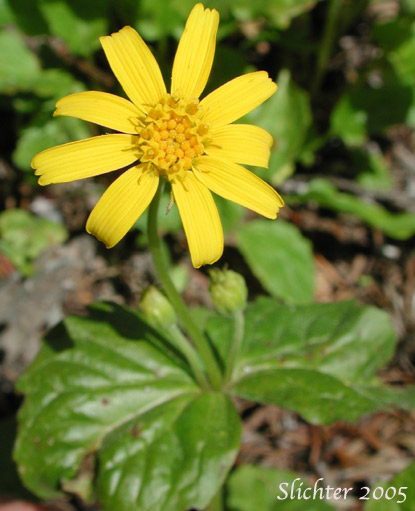
[Arnicas and Leopardbanes: The Genus Arnica East of the Cascade Mountains of Oregon and Washington]

 The photo at right shows the broadly ovate pair of stem leaves found below the inflorescence of mountain arnica. Note that the base of the leaves is sessile.
The photo at right shows the broadly ovate pair of stem leaves found below the inflorescence of mountain arnica. Note that the base of the leaves is sessile.
Mountain arnica is a perennial from 10-60 cm tall. It is a rhizomatous species. Its leaves are deciduous, opposite, and lance- to heart-shaped, with serrate margins. The basal leaves are long-petioled, while the upper of the 2-4 pairs of stem leaves are reduced in size, with shorter petioles or often sessile. The basal and mid-stem leaves range from 2-14 cm long and 1-8 cm wide. The mid-stem leaves may be as large or larger than the basal leaves. The leaves may be smooth or glabrous, or may be hairy.
There may be one to several flower heads. Both disk and ray flowers are present. The flowers are bright yellow. The involucre is 7-18 mm tall somewhat glandular, and occasionally with longer hairs.
Heartleaf arnica (Arnica cordifolia) may hybridize with mountain arnica. This plant was used by Native Americans (the flowers) when steeped in water as a salve to wounds or cuts. The flowers may be grazed by sheep and horses.
Mountain arnica is found in cool, moist forests and meadows, or in rocky places from moderate to high elevation. It is often found in large concentrations where the open forest has been disturbed (Visit the burned area on the Angel's Rest Trail in May and June to see this effect.)
Mountain arnica is found from Alaska south to California, and as far east as Colorado.